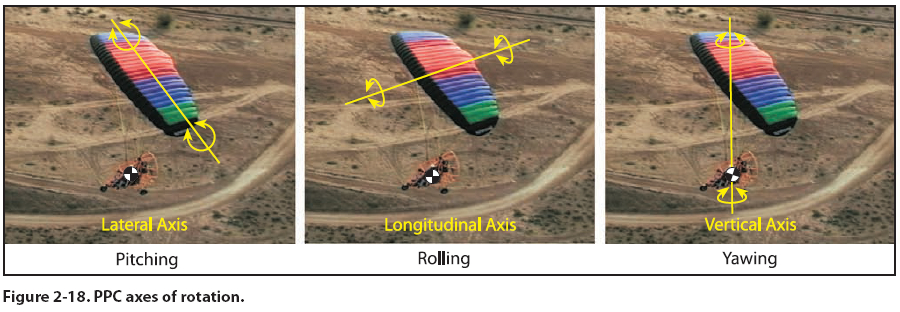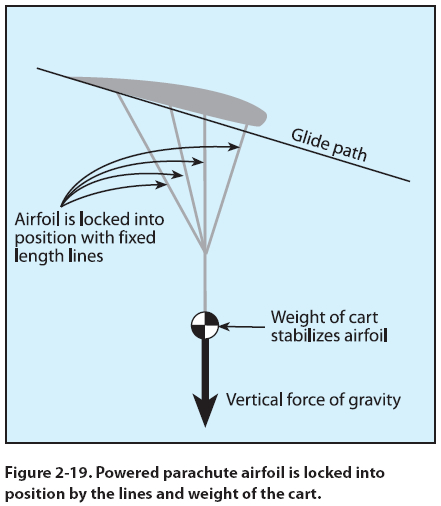Chapter 2 - Aerodynamics of Flight
Axes of Rotation
Motion about the lateral axis or pitch is primarily
controlled by the thrust of the propeller moving the
PPC pitch up (nose up) to climb and pitch down (nose
down) at reduced throttle.
Turning happens about the longitudinal axis and is the
result of the rolling motion similar to an airplane with
aileron and rudder control. To turn, pull down the wing
trailing edge on the side you want to turn to with the
steering controls. This creates drag on the corresponding
trailing edge of the wing, thus dropping the inside
wing, and rolling the PPC into a banked turn. [Figure
2-18]

There is not significant turning about the vertical axis
because the PPC wing is designed to fly directly into
the relative wind just like an airplane. Any sideways
skidding or yaw is automatically corrected to fly
straight with the wing design. An airplane uses the
vertical tail to fly directly into the relative wind like a
dart. The unique design of the PPC performs the same
function through the combination of wing profile/
taper, the arch or curvature from tip to tip, washout
built into the wing and/or tip stabilizer design. These
factors make the PPC track directly into the relative
wind and eliminate the need for a vertical tail surface
and rudder to make coordinated turns. Designs and
methods vary with manufacturer and wing type, but
all PPCs are designed to track directly into the relative
wind.
Ground Effect
Ground effect is the interference of the ground with
the airflow and turbulence patterns created by the
wing. The most apparent indication from ground effect
is the unexpected lift given to an aircraft as it flies
close to the ground — normally during takeoffs and
landings.
Ground effect is usually felt when the wing is at altitudes
of less than half of the wingspan. The typical
PPC wingspan is approximately 38 feet with an average
wing height of about 20 feet. Therefore, ground
effect is negligible for PPCs and is typically not a factor.
Moments
A body that rotates freely will turn about its center
of gravity. In aerodynamic terms for a PPC, the
mathematical value of a moment is the product of the
force times the distance from the CG (moment arm)
at which the force is applied.
Wings generally want to pitch nose down or roll forward
and follow the curvature of the airfoil creating a
negative pitching moment. This is one of the reasons
airplanes have tails. The powered parachute does not
need a tail because the airfoil is locked into a specific
position relative to the cart by the suspension lines.
[Figure 2-19]. Any pitching moment for the wing is
counteracted by the strong pendulum effect (weight
of the cart hanging directly under the center of lift).
Any swinging of the weight creates moments that
act to stabilize the swing. The wing aids to dampen
swinging. This pendulum effect is unique to the PPC
because the cart has the ability to rotate around the
PPC pendulum axis of rotation in addition to rotating
about the CG.

To understand the pendulum effect, attach a small
weight (a pencil or paper clip works) to a 24-inch
string. Note the weight always wants to hang directly
under where you hold it. If you hold the string still
and move the weight to the side, the weight swings
and stabilizes under where you hold it. Gravity, pulling
down on the weight to stabilize it directly under
where it is hanging, is PPC pendulum stability.
[Figure 2-20]

Pendulum stability is the result of a number of PPC
design characteristics: there is no downward force
from a horizontal tail that must be counteracted by the
wing producing more lift; there is no weight of the tail
that must be lifted; and there is no tail to impose extra
drag on the aircraft. Gravity is the primary force that
stabilizes the aircraft using pendulum stability.
The “dynamic pendulum effect” can be demonstrated
by swinging the weight around and then stopping the
swinging to notice that the weight keeps swinging
from the momentum. The swinging weight is known
as the “dynamic pendulum effect” which will be discussed
in detail later.
|

